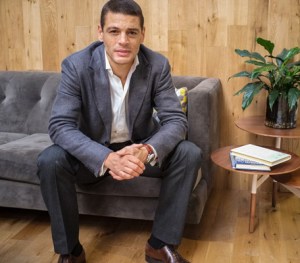Checking In: Jones Lang LaSalle’s Sean Black on Foursquare’s 568 B’way Deal
By Daniel Geiger September 25, 2012 7:00 am
reprintsFoursquare’s Soho offices are bright and open, with a large skylight in the center of the floor that allows sunshine to bathe down on a giant wooden replica of the teardrop-with-a-hole-punched-in-it logo that serves as the company’s locational icon. Look up a bar or a restaurant on Foursquare’s site and this is the tab you will see highlighting its suggestions.
Its prominence is a purposeful reminder of what the company wants to be—a location-based social network that people on the go will use to negotiate daily life—versus what initially brought it fame: a gimmicky online check-in service that has since been handily usurped by not one but two tech giants, Facebook and Twitter.
The tech world is a ruthless place, where battle happens both online and off.

Although it isn’t immediately apparent inside its offices just north of Prince Street and Broadway, where a predominantly 20-something workforce is quietly glued to its computers, the company’s building is itself a component in the battle to regain relevance and profitability.
“Look at this room,” Sean Black told The Commercial Observer last week. “Is this the kind of room where you say to yourself ‘I can’t wait to get out of here?’”
It was a rhetorical question, with the answer clearly being no. We had moved to a small enclosed meeting space, one of several breakout rooms that Foursquare employees can reserve by booking time on an iPad mounted next to its nifty sliding glass doors. Unlike a run-of-the-mill communal space that radiates blandness, the room was outfitted with comfortable couches, plush pillows and a homey décor. Next door was a small private theater for movie screenings.
“It’s a hyper-competitive business, and Foursquare’s product—at the end of the day, the product of any of these tech firms—is its intellectual capital,” Mr. Black said. “They have to compete for the best talent in that industry, and the curb appeal of the space plays a big role in that.”
Foursquare clearly understands this. There were countless details in which creature comforts had been installed or effort taken to create a compelling aesthetic. In the main corridor, exposed steel structural beams with chunky rivets run the length of the floor.
In the office layout that Foursquare inherited, the structural columns had initially been enclosed in a wall. Bringing them out was a nice touch that instilled the space with a feel of the century-old building’s history, a period when the bones of New York City skyscrapers were elegantly laid in cast iron. It was also not an inexpensive undertaking. The paint used to coat the columns is a special fire retardant that cost an estimated $1,000 a gallon.
“There are guys in hazmat suits that apply it, and if they miss even a small spot, they have to do the whole thing over,” said a Foursquare executive who identified himself as Derek.



